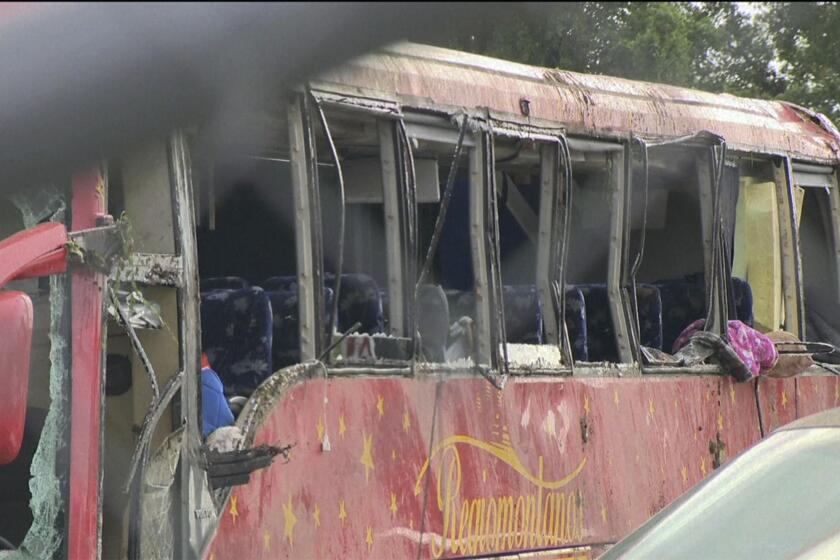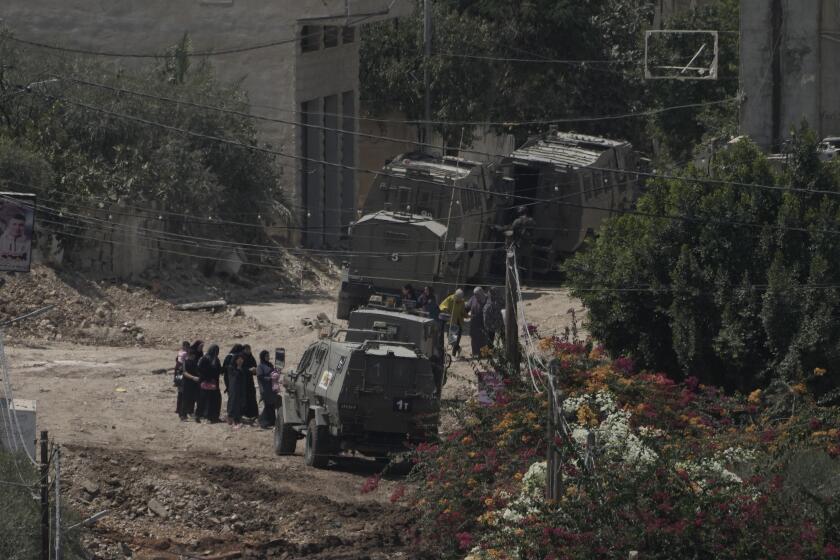Kurdish Children Still Dying Despite Aid From West : Refugees: Food and shelter are being provided, but water is short and sanitation is poor.
The good news is that there is a marked improvement in conditions at mountain camps of half a million refugees along the Turkish-Iraqi border. The bad news is that the children are still dying there at an appalling rate.
A massive U.S.-led supply effort has largely resolved problems of food and shelter, but water is critical in many camps, and adequate sanitation is lacking in all of them, raising fears of epidemics as the weather warms.
In camps where nearly half the refugees are children and nearly all the children have diarrhea, death rates have not declined from early estimates of between 400 and 1,000 per day.
Such were the unanimous conclusions of American, United Nations and private aid specialists interviewed here Thursday as the international relief effort entered its fourth week. Administration of the aid is headquartered in this southeastern Turkish city, which is five hours’ drive from the nearest camp and is the point of entry for most relief supplies.
“There’s a definite improvement, but we’re still climbing. We haven’t reached equilibrium yet,” said Tannis E. Gutnick, a legal expert with the office of the U.N. High Commissioner for Refugees, which is coordinating the relief.
U.S. Army Lt. Col. John Petrella of North Kingstown, R.I., observed: “It’s like trying to get a handle on a grizzly bear. But every day it’s a little bit better. I think we’re getting there.”
Petrella coordinates the actions of the U.S. military and about 50 private relief groups desperate to move aid workers and supplies to remote mountain camps.
All those involved in the effort agree that the only sure end to the suffering is to get the refugees off the mountain perches to which they fled in fear of Iraqi Presdient Saddam Hussein after the collapse of a Kurdish rebellion against him in northern Iraq.
“Things are getting better, but they are still very bad. The only solution is to move these people,” said Anke de Haan, country director for the Paris-based Doctors Without Borders, the first private relief group into the camps.
The United States is building valley refugee camps in a 600-square-mile haven in northern Iraq protected by American, British and Dutch marines and French paratroopers. Hoping that a combination of shelter, supply and security will lure the mostly Kurdish refugees out of the mountains, the United States has told private aid groups to expect the mountain camps to exist for another six to eight weeks, relief workers said Thursday.
An original dozen concentrations of refugees have been consolidated into five major camps. In each of them, four to five dozen U.S. Special Forces troops are working with private relief workers to establish orderly distribution of supplies.
Some inkling of the problem’s enormity is reflected in the fact that, more than three weeks after the refugees started arriving, no one pretends to know for sure how many people are trapped in the mountains. The Turkish government estimates 460,000, but some relief groups say there may be 200,000 more than that.
According to state-run Turkish television, private groups supported by the Turkish government have donated about 13,000 tons of relief supplies, nearly all delivered by truck. The U.S. military said it had delivered 4,500 tons through Monday, principally by air drop and helicopter, and had also delivered much of the several thousand tons of aid from international relief agencies.
“Nobody but the U.S. military could have delivered aid as quickly or as effectively. The presence of American troops has meant an immediate improvement in the camps, but they are still very bad,” said Adrian Cros, a logistic consultant for the United Nations. “The key problem is hygiene. It can take two months to die of starvation but only 72 hours of dehydration.”
The improvement in the supply and quality of potable water is now a priority of the U.S. aid effort, and of international groups as well.
One Swiss helicopter is hauling 20,000 liters of water per day, but in a camp of 100,000 refugees, that represents only about six ounces per person. Water engineers for the British relief group Oxfam are tapping springs above two camps and running pipes down from them.
“There is now more order in most camps,” said Oxfam’s Gillian Gee. “People stand in line for food and water because they are confident more is coming. But if this goes on for six to eight weeks in hot weather, things can only get worse again.”
Growing numbers of mountain graves offer new testimony to the conditions. About 90% of the deaths are children, by one estimate. Although many of the refugees, particularly the middle-class ones, arrived in good health, the rigors of the mountains have taken dreadful toll.
“Nobody I have talked to has been willing to put a number on the mortality. But with the weather turning hot, another four to six weeks will make it increasingly bad despite the presence of medical services,” said Gutnick of the United Nations.
Already, the toll is savage although most of the evidence is anecdotal.
Consultant Cros said he took one of the first aid convoys into the camp at Cukurca early this month. Four refugees died the first day he was there and two the second. Cros said that when he went back last week, 17 died the day he arrived, and 19 had died the day before.
Nocolas de Metz of Doctors Without Borders estimates a death rate of 25 per 10,000 each day in one of the camps and says about 40 die each day at a collection camp called Yekmal, population about 70,000. One U.S. State Department official who has visited Yekmal recently, however, estimates as many as 70 deaths per day there.
“No one is keeping track of deaths, but one thing sure is that sanitation is getting worse. We think the numbers of children and old people dying is higher than it was. Overall, perhaps the number may be 1,000 per day for a population of 500,000, but there are no good numbers,” said Sandy Laumark of the New York-based CARE.
Perhaps what is clearest in a welter of figures and fears, projects and plans, is that despite the vast outpouring of support from around the world, the mountain-bound refugees still have a lot of dying to do.
More to Read
Sign up for Essential California
The most important California stories and recommendations in your inbox every morning.
You may occasionally receive promotional content from the Los Angeles Times.






